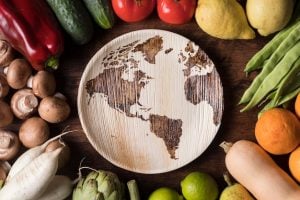Running a food business in 2025 means facing hard truths about rising food costs. These numbers hit both small restaurants and large food service operations, affecting everything from grocery shopping budgets to coffee beans costs. The challenge is significant, with expenses increasing across the board, making it essential to adopt smarter spending habits.
Reducing food costs isn’t about extreme cutbacks that hurt your product—it’s about smart food choices that protect both your budget and reputation. Small changes, like managing your vegetable drawer ready with a full vegetable drawer instead of letting produce go bad, can add up. Cutting back on a daily latte or opting for own coffee instead of fancy toppings on an average cup can also help control recurring expenses.
You don’t need complicated strategies. You need proven methods that work in real kitchens with real people. This guide shows you exactly how to cut overhead and reduce food costs while maintaining quality. From negotiating with suppliers to waste tracking systems and meal prep strategies like meals ahead and using canned foods, we’ll cover what actually works.
The steps here come from actual experience—tested in busy kitchens during rush hours, refined through trial and error, and effective across different food businesses. Whether you’re running a food truck, a restaurant, or looking to cut back on big meals, every tip, technique, and strategy has been verified to help you avoid spending money unnecessarily while still delivering great food. Additionally, understanding external factors such as import tariffs can be crucial to managing food costs effectively. Import tariffs can significantly affect the prices of ingredients, especially those sourced internationally, thereby impacting your restaurant’s overall expenses. For a deeper insight into this topic, exploring how import tariffs affect restaurant costs can help you prepare and adapt your sourcing and pricing strategies accordingly.
Import tariffs are an often overlooked but critical factor that can influence your restaurant’s ingredient costs. These additional charges on imported goods can unpredictably increase prices, especially for items that are sourced internationally or specialty products not available locally. Being aware of current tariff rates and potential changes allows restaurants to plan ahead, negotiate better with suppliers, and adjust menus or sourcing strategies proactively. For a comprehensive understanding, review this detailed explanation on the effects of import tariffs on your restaurant’s bottom line, which covers practical tips to mitigate their impact.
The industry is evolving, presenting both opportunities and challenges. Learning to buy strategically, minimize thoughtless trips to suppliers, and make a complete shift in how you manage toughest expenses can have a big impact. Another crucial factor to consider in cost management is the impact of import tariffs on your food sourcing expenses. Import tariffs can significantly affect the price of ingredients sourced internationally, which in turn influences your overall food costs and menu pricing strategies. Staying informed about current tariff regulations and their effects can help you make smarter purchasing decisions and mitigate unexpected cost increases. For an in-depth understanding, check out this detailed guide on how import tariffs affect restaurant profitability and budgeting.
Industry Growth: The foodservice industry is forecast to reach $1.5 trillion in sales in 2025.
Let’s look at how you can start saving today.

Save 80% of delivery management time
We handle everything:
- Dedicated operations manager
- Real-time tracking dashboard
- Automated customer notifications
- Urgent issue resolution
Step 1: Efficient Budgeting Strategies to Reduce Food Waste
Keep detailed records to track ongoing costs.
Set clear, measurable budget goals.
Leverage modern tools for smarter expense tracking.
Examine Current Costs
Effective budgeting starts with understanding what you’re spending. Capture every single expense. Look at utility bills, wages, food supplies, and others. Use spreadsheets or accounting software. Make sure this audit covers both big and small costs. Without this, you can’t know what’s necessary or what’s wasteful.
Food Price Increases: Wholesale food prices have increased by 7.6% compared to the previous year.
Once costs are logged, spot the non-essential ones. These don’t directly contribute to quality or revenue. Examples might include unused subscriptions or excessive travel expenses. Cutting these helps reduce costs without affecting food quality.
Set Clear Budget Goals
After knowing where your money goes, it’s time to set goals. Break down your financial needs into monthly and yearly numbers. This makes it easier to manage cash flow and avoids stress when large expenses hit. Predictable expenses can be planned ahead, while some wiggle room allows for surprises.
Make sure financial goals support overall business aims. If the goal is to grow next year, budget accordingly. This might mean allocating funds to marketing while reducing in other areas. Such alignment ensures resources are used wisely and keeps quality at the forefront. Some companies are setting ambitious, yet realistic, targets.
Use Modern Budgeting Tools
With goals in mind, streamline tracking with technology. Using tools like QuickBooks or FreshBooks can simplify tracking. They provide real-time overview of expenses and help avoid overspending.
Many programs offer insights into spending habits. Look at these regularly to spot patterns. Maybe there’s a spike in food costs monthly? Understanding trends helps adjust future budgets and ensure resources are used effectively.
Future-Proof Your Strategy
Budgeting regularly can improve growth prospects. Including this fact solidifies the importance of consistent budgeting practices.
By following these steps, businesses can save costs without hurting quality. You prepare the groundwork for smarter financial decisions while maintaining high service and product standards.
Step 2: Cost-Effective Food Sourcing to Save Money
Buy local to lower costs and boost freshness.
Bulk orders can save money if stored right.
Use seasonal buys to cut prices further.
Identify Local Suppliers
Finding local suppliers can save money and improve quality. Local suppliers often offer lower prices for several reasons. Sit down with suppliers. Discuss regular orders and ask about discounts for loyalty. Loyal customers sometimes get the first pick on new or fresh stock. This can make a difference in both cost and quality. Such relationships are built over time and can be beneficial in getting the best deals available.
Choosing local suppliers cuts down on the distance food has to travel. Less distance means less spent on transport. Freshness is another win here. Shorter transport times usually mean fresher food on arrival, keeping quality high. Shorter times also mean fewer risks of transport-related issues, like spoilage.
Understand Available Resources and Products
Local suppliers offer more than just cost benefits. They provide insights into what’s in season and might offer products not found elsewhere. Learning about these resources can open up new menu ideas. It’s vital to stay informed about what they can offer and leverage this information to adjust your purchasing and menu planning accordingly.
Bulk Purchasing Techniques
Buying in bulk often leads to price cuts. But it requires planning. When you buy more, you often pay less per unit. This doesn’t happen automatically, though. You need to actively talk about prices. Ask for discounts when orders reach a certain size. Some suppliers offer sliding scales, where prices drop as order sizes increase. This agreement can be very beneficial for both parties.
Bulk purchases need space. Without proper storage, you risk spoilage. Before committing to a large order, assess your storage. Make sure everything is well-organized. Products should be easy to access and clearly labeled. This helps in managing inventory levels effectively. Regular checks can prevent shortages and overstock issues.
Optimize Storage Conditions
Conditions like temperature and humidity matter for storage. Foods like dry goods, fresh produce, and meats have different needs. By tailoring storage to each type, waste is minimized. Keeping track of inventory using tools or systems aids in preventing loss and allows for better planning on when to reorder.
Seasonal Buying
The price of food often drops when it’s in season. This technique not only enhances flavor and quality but also provides financial benefits.
Track what’s in season each month. Foods in season are often cheaper and taste better. These items usually have a higher supply, which drives prices down. Plus, in-season ingredients can often be sourced locally, which further reduces costs. Being mindful of overall food price trends is also crucial.
Projected Food Price Inflation: In 2025, food prices are predicted to increase by 1.9%, with grocery food prices expected to rise by 0.8%.
Adjusting your menu in line with these seasonal shifts is wise. This requires some flexibility and creativity in menu planning. By adopting this approach, you introduce variety while keeping costs low. Regularly updating the menu based on seasonal trends can be a marketing strategy to attract customers with fresh offerings.
By focusing on this overall strategy, savings on food costs can be considerable without dropping quality. These practices align well with business goals, keeping both chefs and accountants happy.

Step 3: Quality-Driven Financial Management
Train staff to use resources well.
Check supplier deals for better prices.
Cut food waste to save money.
Invest in Employee Training
Training your staff can save money and improve quality. Teach them to handle resources efficiently. This includes knowing exact portion sizes, proper storage procedures, and cooking methods that reduce waste. This ensures that your employees use every ingredient to its fullest potential. When staff have the skills to minimize waste, the overall costs decrease while maintaining the quality of your dishes. The workforce is a significant part of the industry’s strength.
Projected Employment: The restaurant industry is expected to employ 15.9 million people by the end of 2025, adding 200,000 jobs.
Enhancing skills also improves service quality. More confident and knowledgeable employees can provide better customer service. This can lead to higher customer satisfaction and increased return visits. Training programs could include cooking workshops, customer service training, and health and safety seminars. Consider partnering with local culinary schools or bringing in experts for hands-on training sessions. However, labor costs are also a factor to consider.
Evaluate Training Effectiveness
Assess how well the training works. Monitor performance through regular feedback and reviews. Check if there’s a noticeable decrease in resource usage and waste. Adjust your training as needed. Use evaluations to highlight areas needing improvement or expansion. This ensures that your investment in training continues to pay off.
Regularly Evaluate Supplier Contracts
Suppliers are a big part of controlling costs. Regularly review your contracts to ensure you’re getting the best deal. Check if their prices are competitive. Prices can fluctuate, so a yearly review is wise. Look at market trends and compare with what you’re paying. Some businesses are proactive about managing price increases.
Consider renegotiation options. Prices might have gone down, or a better supplier could have emerged. A simple request to explore new terms can result in better arrangements. Aim for long-term relationships with suppliers who consistently deliver quality at a fair price. Loyalty can sometimes lead to additional benefits, such as priority in scarce times.
Identify Cost-Effective Alternatives
Keep an eye out for alternatives. Sometimes, a new supplier might offer better products or rates. Stay informed about industry changes. Attend trade shows or network with others in the industry for insights into new opportunities or trends. Consider dietary shifts as well.
Implement Waste Reduction Programs
Food waste is a major cost. Restaurants generate billions of pounds in waste each year, costing the industry massive amounts. Tracking food waste is crucial. Implement programs that audit waste production, from preparation leftovers to plate waste. Use this data to adjust your purchasing. For example, if half a pound per meal gets wasted, buying less could save thousands. The financial impact of waste is substantial.
Encourage all staff to get involved. Instill a culture of waste reduction. Simple practices like proper stock rotation and clear labeling can reduce spoilage. Motivate employees with incentives for innovative waste-saving ideas. Engage with customers too, perhaps by offering customizable portion sizes which can also decrease waste.
Vegetarian Savings: A vegetarian diet can save consumers an average of $32.59 per week on groceries.
People keep an eye on restaurants with waste management practices when choosing where to eat. Turn waste reduction into an advantage by using it in your marketing. This can attract more environment-conscious customers, boosting both reputation and revenue. To assist in managing your food costs efficiently, consider using a helpful tool: a simplified recipe costing template. This can streamline your pricing process, ensuring you account for every ingredient and its cost, which enhances your budgeting strategies.
Household Food Waste: The average American family of four discards more than $3,000 worth of groceries each year.
Monitor and Adjust Programs
Regularly check if the waste programs work well. Collect data and see where adjustments are necessary. Keep staff informed and involved through consistent communication and training updates. Reinforce successful practices while introducing new strategies if needed.
Advanced Tips for Innovative Overhead Reduction Techniques
Cut utilities and waste with green initiatives.
Balance staffing with smart scheduling.
Implement Green Practices
Businesses can lower utility expenses by focusing on sustainable energy solutions. Start with energy-efficient appliances and lighting. For example, LED lights consume less energy compared to regular bulbs. Also, embrace the potential of motion sensors to decrease energy use in unused spaces.
Think more about comprehensive recycling strategies. Consider everything from paper and plastic to food waste. In fact, food waste recycling can even provide your company with compost for gardens. Research materials to fully understand the recycling process you can implement within your business. “Cradle to Cradle: Remaking the Way We Make Things” by William McDonough and Michael Braungart offers extensive insights into eco-friendly practices. Not only do these strategies help the planet, but they also lead to notable savings in disposal costs.
Counterarguments often involve the initial investment needed for green technology. However, the gradual savings in utility bills and waste reduction often outweigh these costs. For continuous learning about these practices, government websites and sustainability workshops are practical resources.
Optimize Staff Schedules
Accurate forecasting of busy periods is crucial for proper staffing. Use software tools to track patterns, which can predict peak customer hours. This data ensures employees are scheduled effectively during high demand, leading to improved operations without overwhelming payroll.
There’s also a need to address overtime expenses. Start with smart scheduling systems like Deputy or When I Work. These tools help managers create schedules that minimize unnecessary overtime. Research has shown that reducing overtime keeps operational costs down and improves employee satisfaction. Malcolm Gladwell’s “Outliers” discusses insights on productivity and management, providing a deeper understanding of effective workplace strategies. Many businesses are proactively managing staffing levels.
There may be pushback from traditional scheduling norms. While flexibility in scheduling is important, it’s vital to establish clear guidelines. Tutorials and industry-specific webinars can offer further knowledge on this topic.

Troubleshooting Common Issues
Supply chain disruptions? Try new vendors.
Spot quality drops? Keep strict standards.
Avoid guesswork with hands-on solutions.
Solutions to Potential Problems
Diversifying Vendors to Tackle Supply Chain Disruptions
Assess Current Vendors
Start by looking at your existing vendors. Understand their strengths and weaknesses. Check if they’re meeting expectations or causing delays. Make use of reports to find patterns in delivery times and reliability.
Research New Vendors
Explore potential vendors. Use trade shows, industry publications, and online platforms. Identify those who align with your quality and cost needs. Look for reviews and ask for references to verify past performance.
Establish Contacts
Once you’ve short-listed new vendors, reach out. Visit their facilities if possible. Observe their operations and ask specific questions about their practices and capacity to deliver.
Negotiate Terms
Negotiate terms keeping flexibility in mind. Discuss payment terms, delivery schedules, and possible discounts for long-term collaboration. Diversification is key, so don’t rely excessively on one vendor.
Pilot Testing
Before committing, run a small trial. This helps test their reliability and quality. Ensure everything meets your standards before scaling up. Adjust contracts based on trial outcomes.
Maintaining Strict Standards to Prevent Quality Drops
Define Quality Metrics
Set clear standards for what quality means to your business. Outline these metrics in every contract with suppliers. Make these measurable and aligned with your business expectations.
Regular Inspections
Schedule regular quality checks. Inspect incoming products and document each inspection. Look for inconsistencies early to address them before they reach your customers.
Feedback Loops
Create a feedback system with your suppliers. This ensures you can communicate issues quickly and work towards resolutions. Aim for a collaborative relationship focused on improvements.
Training Internal Teams
Train your team to understand quality benchmarks. They must understand how to check for inconsistencies. Periodic workshops help in skill enhancement to identify and address quality issues promptly.
Adapt and Iterate
Quality maintenance is an ongoing process. Regularly assess your standards. Adapt to changes in the industry, customer needs, or manufacturing processes.
With these steps, you’ll effectively manage and resolve common issues in overhead and food costs management. Implementing these practical solutions will not only solidify your supply chain but also ensure quality is never on the line.
Further Resources and Reading
Cutting costs without losing quality is a big deal for today’s businesses.
Using the right tools can make a huge difference in managing budgets.
Understanding industry impacts helps predict future trends. The industry’s economic contribution is significant.
Related Topics or Advanced Guides
To dive deeper into operational cost reduction, case studies offer relatable stories and practical examples. Studies have shown that learning from others’ successes and failures provides valuable insights. For instance, examining how small businesses successfully cut costs without losing quality can teach pivotal lessons.
Similarly, software solutions can revolutionize budget management. Business budgeting software like Scoro or Planguru caters to different business sizes, with each solution having distinct features. Some tools integrate real-time tracking or predictive analytics, significantly enhancing financial decision-making. An example of effective use is UPS’s ORION system, which optimizes delivery routes and cuts fuel costs.
Why This Skill/Task Matters
Managing costs efficiently offers sustained benefits. It’s not just about savings but ensuring business sustainability. As Jeff Bezos said, “Competing on price alone is a race to the bottom.” By focusing on the long-term gains of well-managed expenses, businesses ensure a stable financial ground.
Furthermore, skillful management of resources leads to an improved reputation and stronger brand loyalty. By prioritizing value over mere costs, companies can offer better products or services, and customers recognize and reward this effort.
Contextualize the Importance of the Skill or Task
The food and service industries show a profound economic impact. With the restaurant industry expected to contribute significantly to the U.S. economy, managing costs effectively is critical. Overall sales are a key indicator of this impact.
Total Sales Projection: The restaurant industry is projected to reach $1.1 trillion in sales in 2025, marking a 4% increase from the previous year.
However, reducing expenses shouldn’t mean sacrificing quality; innovative strategies are key. For instance, implementing green practices can lower utility costs while boosting brand image.
Real-world successes further illustrate these approaches. For example, a well-known restaurant chain reduced their food waste through better inventory tracking and trained staff, leading to substantial savings. It highlights that focusing on internal processes can help save money and maintain product quality.
Conclusion
Smart cost management in food service is about finding balance, especially in the face of rising food costs. The steps outlined show how to save money on food costs while maintaining high food quality. By focusing on efficient budgeting, smart food sourcing from grocery stores and farmers markets, and quality-driven management, businesses can reduce expenses without losing customers.
Success in cutting costs requires a systematic approach. Start by examining recurring costs, then build relationships with local suppliers to access special deals and bulk-buying opportunities. Finally, implement food waste reduction programs by monitoring inventory and making use of canned or frozen produce and meal prep strategies like freezer meals and slow cooker meals. Each step builds on the previous one, creating a strong foundation for financial stability.
The most effective cost-cutting strategies often come from staff involvement. When employees understand the importance of resource management and receive proper training, they become active participants in reducing waste food and avoiding wasting money. This creates a culture of efficiency that extends beyond immediate savings, benefiting both the food budget and overall operations.
Remember that cutting food costs is an ongoing process. Regularly evaluate supplier contracts, encourage making lunch in-house instead of dining at an expensive restaurant, and track weekly ads for big savings on essential items. Simple steps, like reducing coffee costs by cutting back on a daily latte or making use of a dedicated drawer for fresh produce to avoid rotten zucchini, can make a big difference.
Take one action today: Review your food bill, identify three areas where you can reduce food waste, and consider meal prepping or choosing ready-to-go meals to streamline operations. Small changes, when applied consistently, lead to significant long-term savings without sacrificing quality.



























